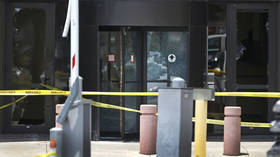Why can’t even a pandemic lockdown stop Americans from being gunned down in mass shootings?

In the US, the immediate impact of Covid-19 seems to be a sharp drop in crime, except for one major category. About twice as many people have died in mass shootings this March as in the same time in previous years.
In March of 2018, there were 10 deaths from mass-shootings. In March of 2019, there were 12 deaths. During this March, under the quarantine conditions of a pandemic, there were 26 mass-shooting fatalities. The number of wounded has also increased this March compared to the last.
The United States has had the most mass shootings of any country, and even in the midst of a pandemic, the rate is not declining.
With Covid-19 impacting social behavior, many forms of crime have ebbed, at least for now. In New York City, the area hardest hit by the outbreak, the number of serious felonies dropped 16.6 percent from March 16 to March 22 compared to the same period in 2019, according to The Wall Street Journal. Burglaries and assaults were each down about 18 percent compared with the previous week.
Against this trend, the fact that the mass-shooting statistics are actually slightly worse than the same period in previous years emphasizes how intractable the culture of mass-shooting violence is in America. The propensity for violence and the high-frequency of incidents is such that the numbers are unaffected even by unprecedented circumstances, when almost all citizens are off the streets.
What is keeping these mass-shooting numbers up, even in the midst of a massive social emergency like Covid-19? In large part, the proportion of gang violence has held steady in troubled neighborhoods that are flouting quarantine orders, lending credence to the argument of conservatives that it is inner-city gangs that are driving the numbers, and emphasizing their view that firearm regulations are an unnecessary impingement on their rights as responsible gun owners.
There were multiple events in gang-ridden counties of Maryland, and Detroit and Atlanta. A gunman in Tulare, California opened fire on a group of more than 50 people gathered following the burial of a man who died in a car crash, killing one man and wounding five others, including a little girl. Another incident was at a Maryland shopping plaza, outside an event at a dance studio. In another neighborhood, a mass shooter fired into a crowd that had gathered for a birthday party for a man who had died a few days earlier. A man was killed and 17 other people were wounded after gunfire erupted at a party involving multiple motorcycle clubs in Ohio. In all these instances, investigators said the groups should not have been gathering due to the stay-at-home order in place during the Covid-19 pandemic.
Gang violence, however, did not account for all the mass-shootings in March. A man killed six family members before turning the gun on himself Sunday evening in the rural Moncure area of North Carolina.
Data collected by the National Gang Center, the government agency responsible for cataloging gang violence, can help determine whether America has a gang problem or a gun problem. While the number of gangs and gang members has been on the rise for several decades, there has been a decrease in gang-related homicides. With gang membership and gun homicide rates moving in opposite directions, it mitigates against the argument that gang violence is truly driving the homicide rate.
Also on rt.com US jobless claims surge to record 10 MILLION amid coronavirus lockdownThe cultural divide in the US prevents anything meaningful being done to reduce the scale of such horrific events. The rate of mass-shootings hasn’t decreased, even as the country is hunkering down behind closed doors. The stubborn rate of such incidents, in the midst of a pandemic, is highlighting numerous cultural fault lines in the US: the political and cultural divisions, the cycle of violence and harsh socioeconomic conditions of many inner cities, and a latent insinuation about race: gang violence, for many, typically implies African-American gang violence. As a sad consequence, not even a pandemic can stop Americans from being gunned down in mass-shootings.
People ran to gun stores in record numbers in March, seeking self-defense weapons amid the coronavirus scare, driving sales up about 83 percent. Handgun sales jumped 91 percent over March 2019, and rifles surged 73 percent. America already has the most guns per head of population in the world. No other country is even remotely close. In the United States, 42 percent of households have one or more guns. Mass shootings in schools, night clubs, at concerts, churches, and in the streets have become commonplace. Many elementary schools practice ‘active-shooter’ scenarios, and the architecture of new schools is being designed to make hallways shaped to reduce the target environment for would-be shooters. The US gun homicide rate is 25 times that of other high-income countries. More than half of American adults or someone they care for have experienced gun violence in their lifetime.
Gangs may be indifferent to viruses and public restrictions; but the incidents are happening all over the country, and the worst incidents: in the Pulse Nightclub, and El Paso, and Las Vegas, were lone-wolf gunmen, armed with what various US laws define as assault weapons. Not even a pandemic can mitigate against a chronic problem at the heart of American society.
If you like this story, share it with a friend!
The statements, views and opinions expressed in this column are solely those of the author and do not necessarily represent those of RT.













